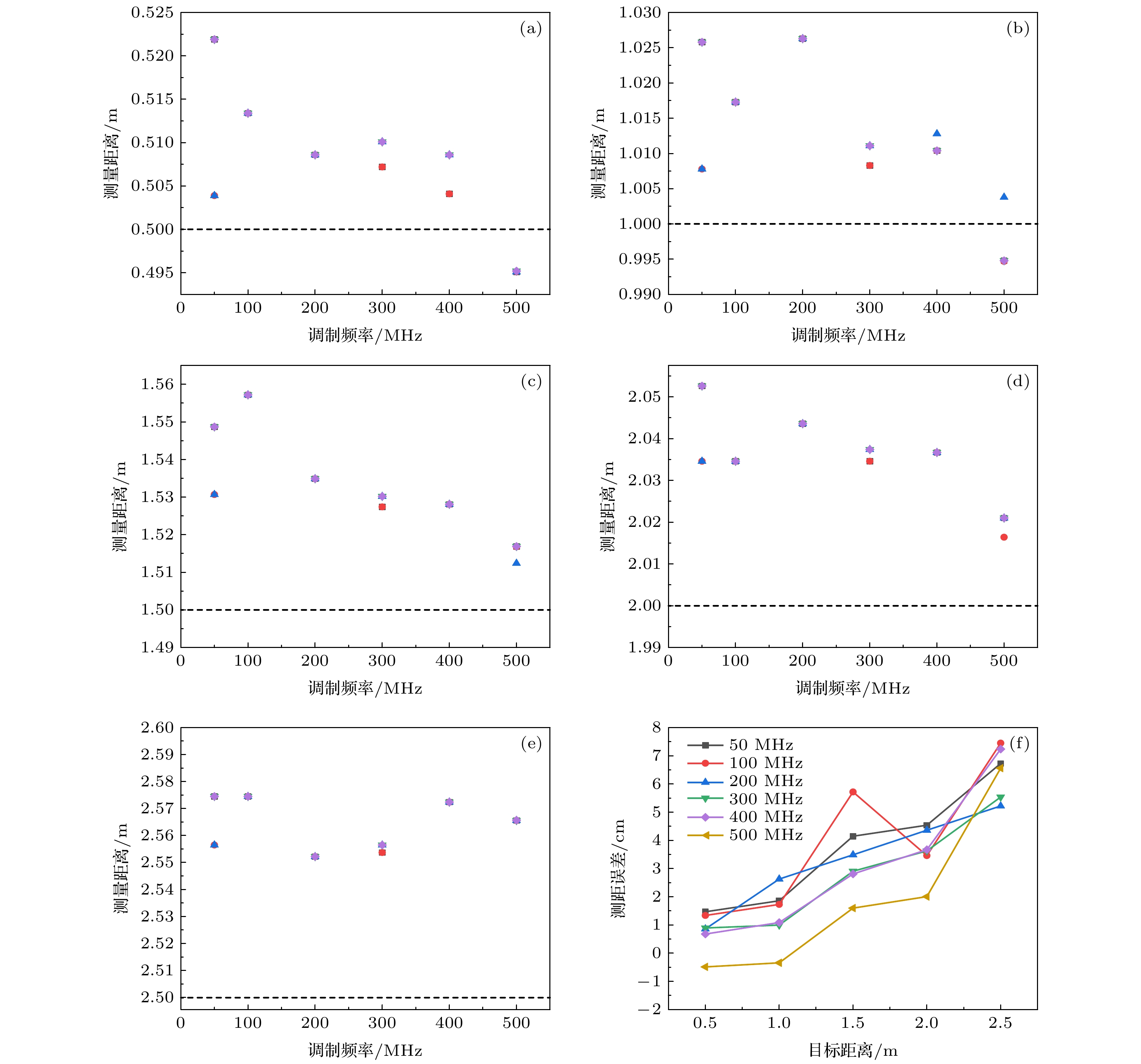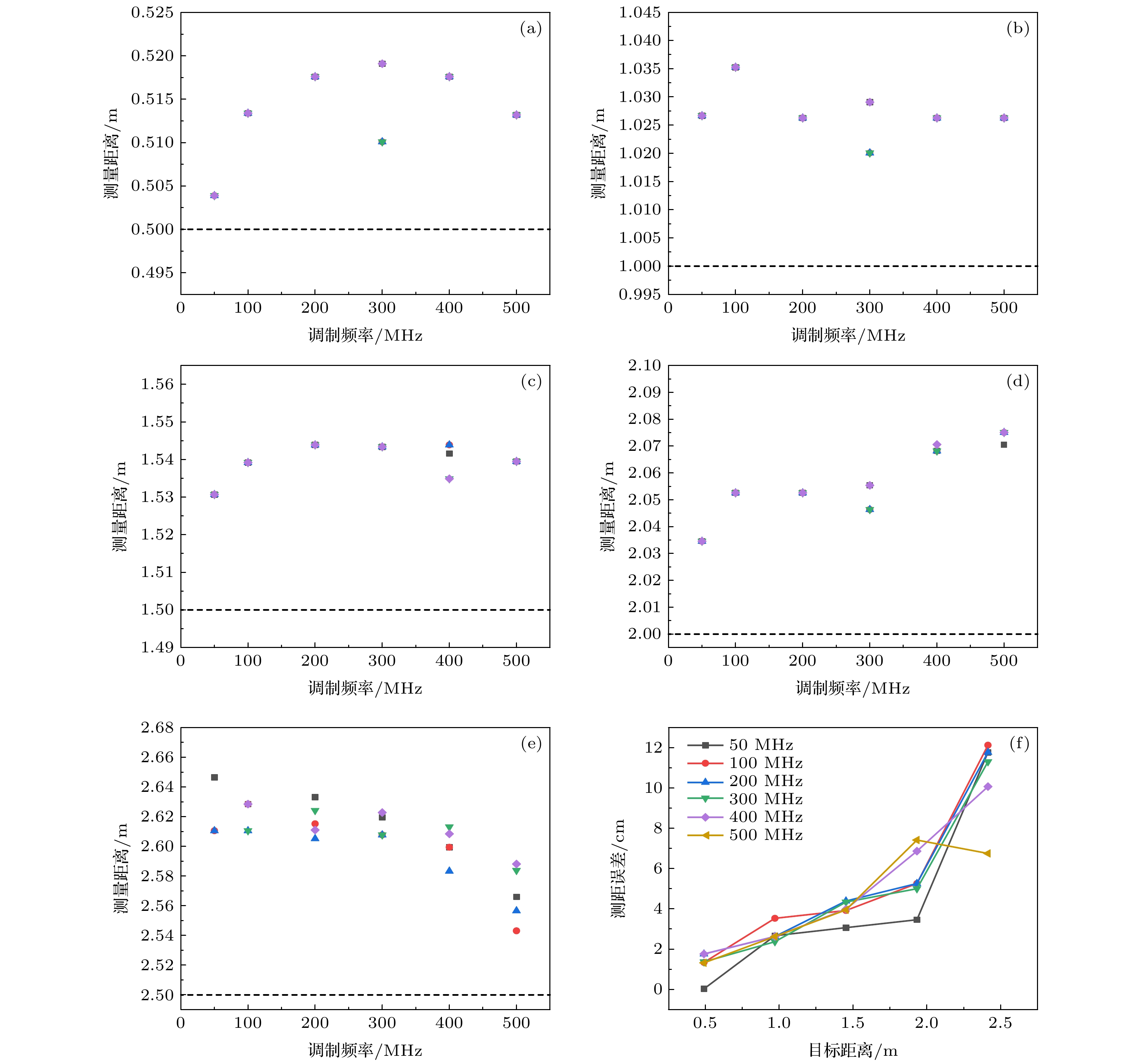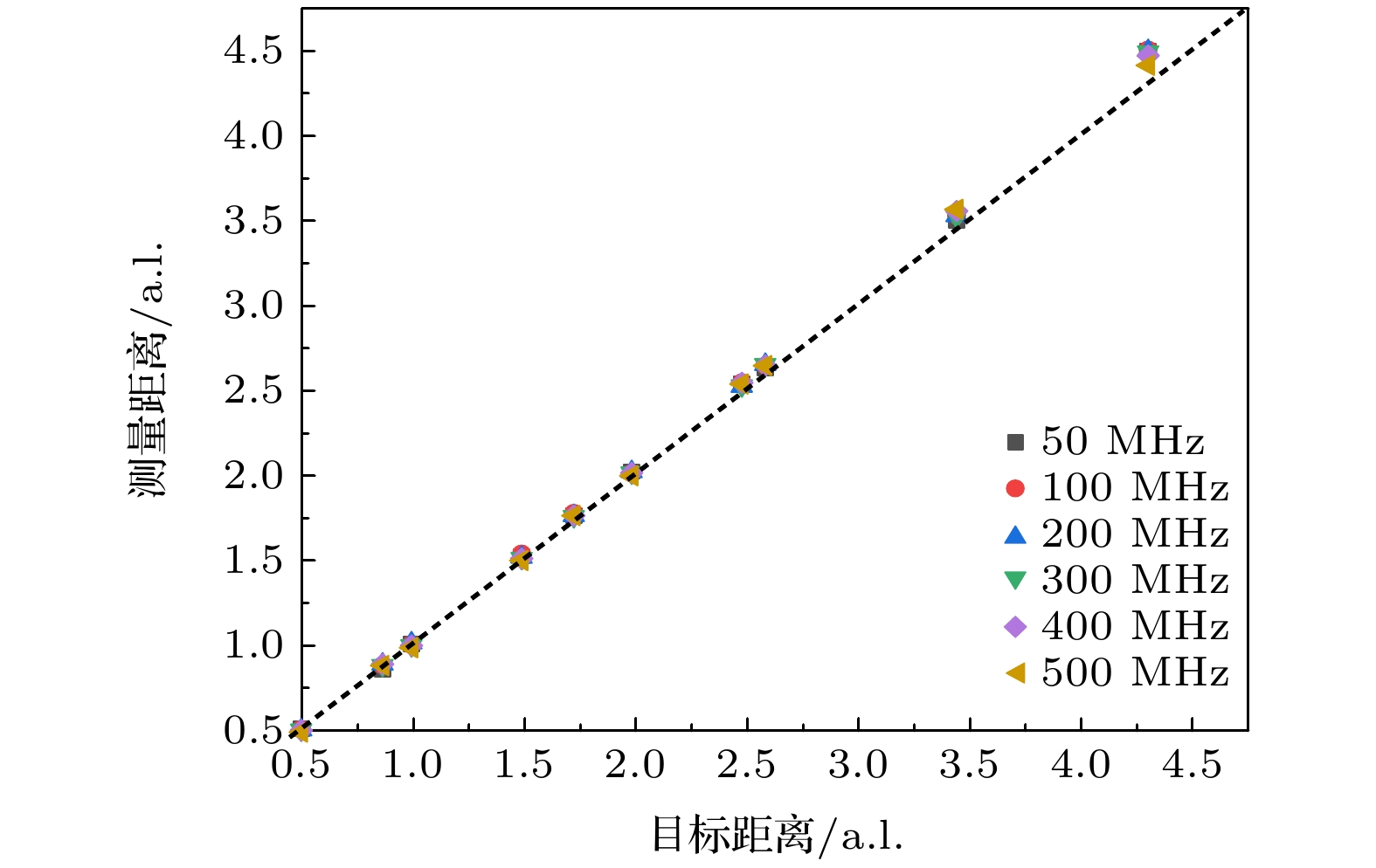-
Laser underwater detection has important applications in underwater target search, resource exploration, and other fields. The absorption and scattering of light by water are a big challenge to underwater detection. Absorption causes the laser signal to attenuate, thus limiting the detection distance. Scattering causes not only attenuation but also noise, the strong scattering noise can even submerge the target information. To reduce the absorption, the blue-green light band in the transmission window of water is chosen for lidar. Optically carried microwave radar (OCMR) has the advantages of resistance to turbulence and scattering. The intensity of the detection beam is modulated at radio frequency. The photons reflected by the target retain the intensity modulation information, while interference phase-out is generated between photons scattered by particles suspending in turbid water at different distances, resulting in the average of high-frequency modulation signals. The signal-to-noise ratio is improved when the received signal by the detector is correlated with the modulation signal. High-power broadband intensity modulated light source is the key to achieving the long-distance, high-precision underwater ranging with the carrier modulation method. However, the carrier modulation technology for underwater detection is limited by the development of light source. The maximum power of intensity modulation green light used in underwater detection is on the order of hundreds of milliwatts, the receiver needs to adopt a photomultiplier tube (PMT). In this paper, a laser underwater detection system is built with a 3-m-long water tank by using a home-made 532 nm light source. The maximum output power of the intensity-modulated 532 nm laser is 2.56 W. The modulation frequency is turned from 10 MHz to 2.1 GHz. Water with different attenuation coefficients is obtained by adding Mg(OH)2 into the water tank. When the maximum modulation frequency is 500 MHz by phase ranging, 4.3 attenuation lengths(a.l.) are measured. The ranging error is about 12 cm. In the future study, a PMT will be used as the detector to increase the range resolution. We will also increase the bandwidth of the signal processing unit in order to take full advantage of the broadband intensity to modulate light source. -
Keywords:
- laser /
- intensity modulation /
- underwater ranging /
- correlation calculation
[1] Jaffe J S 2015 IEEE J. Oceanic Eng. 40 683
 Google Scholar
Google Scholar
[2] Busck J 2005 Opt. Eng. 44 16001
 Google Scholar
Google Scholar
[3] Austin J, William J, Alan L, Linda M, Brandon C 2018 Opt. Express 26 2668
 Google Scholar
Google Scholar
[4] Laux A, Mullen L, Perez P, Zege E 2012 Proceedings of SPIE on Ocean Sensing and Monitoring Baltimore, USA, April 23, 2012 p8372
[5] Haltrin V I 1998 Appl. Opt. 37 3773
 Google Scholar
Google Scholar
[6] Duntley S Q 1963 J. Opt. Soc. Am. 53 214
 Google Scholar
Google Scholar
[7] Mullen L J, Contarino V M 2002 IEEE Microwave Mag. 1 42
[8] Illig D W, Rumbaugh L, Jemison W D, Alan L, Linda M 2014 Proceedings of IEEE International Conference on Oceans IV St. John's, Canada, September 14–19, 2014 p7003086
[9] O'Connor S, Lee R, Mullen L, Cochenour B 2014 Proceedings of SPIE on ocean Sensing and Monitoring VI Baltimore, USA, May 6–7, 2014 p91110P
[10] Illig D W, Laux A, Lee R W, Jemison W D, Mullen L J 2015 Proceedings of SPIE on Ocean Sensing and Monitoring VII Baltimore, USA, April 20–24, 2015 p94590B
[11] 张洪敏, 荣健, 李涛, 田磊, 汤林, 梁国栋 2011 红外与激光工程 40 2408
 Google Scholar
Google Scholar
Zhang H M, Rong J, Li T, Tian L, Tang L, Liang G D 2011 Infrared Laser Eng. 40 2408
 Google Scholar
Google Scholar
[12] Illig D W, Jemison W D, Lee R W, Lauxb A, Mullenet L 2014 Proceedings of SPIE on ocean Sensing and Monitoring VI Baltimore, USA, May 6–7, 2014 p91110R
[13] 张明涛, 张建忠, 张建国, 徐航, 张明江, 王安帮, 王云才 2016 激光与光电子学进展 53 051402
 Google Scholar
Google Scholar
Zhang M T, Zhang J Z, Zhang J G, Xu H, Zhang M J, Wang A B, Wang Y C 2016 Laser Optoelect. Prog. 53 051402
 Google Scholar
Google Scholar
[14] 沈振民, 尚卫东, 王冰洁, 赵彤, 张海洋, 郑永超, 周国清 2020 光子学报 49 0601001
 Google Scholar
Google Scholar
Shen Z M, Shang W D, Wang B J, Zhao T, Zhang H Y, Zheng Y C, Zhou G Y 2020 Acta Photonica Sin. 49 0601001
 Google Scholar
Google Scholar
[15] 戴永江 2010 激光雷达技术 (下册) (北京: 电子工业出版社) 第586—588页
Dai Y J 2010 Lidar Technology (Vol. 2) (Beijing: Electronic Industry Press) pp586–588 (in Chinese)
[16] 宋宏, 张云菲, 吴超鹏, 申屠溢醇, 吴超钒, 郭乙陆, 黄慧, 司玉林, 杨萍, 全向前 2019 红外与激光工程 48 0406008
 Google Scholar
Google Scholar
Song H, Zhang Y F, Wu C P, S Y C, Wu C F, Guo Y L, Huang H, Si Y L, Yang P, Quan X Q 2019 Infrared Laser Eng. 48 0406008
 Google Scholar
Google Scholar
[17] 刘邈, 杨学友, 刘常杰 2012 中国激光 39 0208004
 Google Scholar
Google Scholar
Liu M, Yang X Y, Liu C J 2012 Chin. J. Las. 39 0208004
 Google Scholar
Google Scholar
[18] 姜成昊, 杨进华, 张丽娟, 王晓坤 2014 光子学报 43 0912006
 Google Scholar
Google Scholar
Jiang C H, Yang J H, Zhang L J, Wang X K 2014 Acta Photonica Sin. 43 0912006
 Google Scholar
Google Scholar
[19] Shangguan M J, Xia H Y, Wang C, Qiu J W, Lin S F, Dou X K, Zhang Q, Pan J W 2017 Opt. Lett. 42 3541
 Google Scholar
Google Scholar
[20] 章正宇, 眭晓林 2002 中国激光 29 661
 Google Scholar
Google Scholar
Zhang Z Y, Sui X L 2002 Chin. J. Las. 29 661
 Google Scholar
Google Scholar
[21] 刘颖, 吕彦东, 孙志成, 张娜 付庆勇 2019 遥测遥控 40 56
 Google Scholar
Google Scholar
Liu Y, Lv Y D, Sun Z C, Zhang N, Fu Q Y 2019 J. Telemetry Tracking Command 40 56
 Google Scholar
Google Scholar
-
表 1 不同水体的衰减系数
Table 1. Attenuation coefficient of different water.
样本 目标距
离/m回波信号
强度/mW衰减系
数/m–1平均衰减
系数/m–11 0 160 — 0.99 0.50 60 0.98 1.00 22 0.99 1.50 8 1.00 2 0 261 — 1.72 0.50 47 1.71 0.80 17 1.71 1.00 8 1.74 3 0 216 — 2.97 0.20 68 2.89 0.30 35 3.03 0.50 11 2.98 4 0 230 — 4.03 0.20 47 3.97 0.25 30 4.07 0.40 9 4.05 -
[1] Jaffe J S 2015 IEEE J. Oceanic Eng. 40 683
 Google Scholar
Google Scholar
[2] Busck J 2005 Opt. Eng. 44 16001
 Google Scholar
Google Scholar
[3] Austin J, William J, Alan L, Linda M, Brandon C 2018 Opt. Express 26 2668
 Google Scholar
Google Scholar
[4] Laux A, Mullen L, Perez P, Zege E 2012 Proceedings of SPIE on Ocean Sensing and Monitoring Baltimore, USA, April 23, 2012 p8372
[5] Haltrin V I 1998 Appl. Opt. 37 3773
 Google Scholar
Google Scholar
[6] Duntley S Q 1963 J. Opt. Soc. Am. 53 214
 Google Scholar
Google Scholar
[7] Mullen L J, Contarino V M 2002 IEEE Microwave Mag. 1 42
[8] Illig D W, Rumbaugh L, Jemison W D, Alan L, Linda M 2014 Proceedings of IEEE International Conference on Oceans IV St. John's, Canada, September 14–19, 2014 p7003086
[9] O'Connor S, Lee R, Mullen L, Cochenour B 2014 Proceedings of SPIE on ocean Sensing and Monitoring VI Baltimore, USA, May 6–7, 2014 p91110P
[10] Illig D W, Laux A, Lee R W, Jemison W D, Mullen L J 2015 Proceedings of SPIE on Ocean Sensing and Monitoring VII Baltimore, USA, April 20–24, 2015 p94590B
[11] 张洪敏, 荣健, 李涛, 田磊, 汤林, 梁国栋 2011 红外与激光工程 40 2408
 Google Scholar
Google Scholar
Zhang H M, Rong J, Li T, Tian L, Tang L, Liang G D 2011 Infrared Laser Eng. 40 2408
 Google Scholar
Google Scholar
[12] Illig D W, Jemison W D, Lee R W, Lauxb A, Mullenet L 2014 Proceedings of SPIE on ocean Sensing and Monitoring VI Baltimore, USA, May 6–7, 2014 p91110R
[13] 张明涛, 张建忠, 张建国, 徐航, 张明江, 王安帮, 王云才 2016 激光与光电子学进展 53 051402
 Google Scholar
Google Scholar
Zhang M T, Zhang J Z, Zhang J G, Xu H, Zhang M J, Wang A B, Wang Y C 2016 Laser Optoelect. Prog. 53 051402
 Google Scholar
Google Scholar
[14] 沈振民, 尚卫东, 王冰洁, 赵彤, 张海洋, 郑永超, 周国清 2020 光子学报 49 0601001
 Google Scholar
Google Scholar
Shen Z M, Shang W D, Wang B J, Zhao T, Zhang H Y, Zheng Y C, Zhou G Y 2020 Acta Photonica Sin. 49 0601001
 Google Scholar
Google Scholar
[15] 戴永江 2010 激光雷达技术 (下册) (北京: 电子工业出版社) 第586—588页
Dai Y J 2010 Lidar Technology (Vol. 2) (Beijing: Electronic Industry Press) pp586–588 (in Chinese)
[16] 宋宏, 张云菲, 吴超鹏, 申屠溢醇, 吴超钒, 郭乙陆, 黄慧, 司玉林, 杨萍, 全向前 2019 红外与激光工程 48 0406008
 Google Scholar
Google Scholar
Song H, Zhang Y F, Wu C P, S Y C, Wu C F, Guo Y L, Huang H, Si Y L, Yang P, Quan X Q 2019 Infrared Laser Eng. 48 0406008
 Google Scholar
Google Scholar
[17] 刘邈, 杨学友, 刘常杰 2012 中国激光 39 0208004
 Google Scholar
Google Scholar
Liu M, Yang X Y, Liu C J 2012 Chin. J. Las. 39 0208004
 Google Scholar
Google Scholar
[18] 姜成昊, 杨进华, 张丽娟, 王晓坤 2014 光子学报 43 0912006
 Google Scholar
Google Scholar
Jiang C H, Yang J H, Zhang L J, Wang X K 2014 Acta Photonica Sin. 43 0912006
 Google Scholar
Google Scholar
[19] Shangguan M J, Xia H Y, Wang C, Qiu J W, Lin S F, Dou X K, Zhang Q, Pan J W 2017 Opt. Lett. 42 3541
 Google Scholar
Google Scholar
[20] 章正宇, 眭晓林 2002 中国激光 29 661
 Google Scholar
Google Scholar
Zhang Z Y, Sui X L 2002 Chin. J. Las. 29 661
 Google Scholar
Google Scholar
[21] 刘颖, 吕彦东, 孙志成, 张娜 付庆勇 2019 遥测遥控 40 56
 Google Scholar
Google Scholar
Liu Y, Lv Y D, Sun Z C, Zhang N, Fu Q Y 2019 J. Telemetry Tracking Command 40 56
 Google Scholar
Google Scholar
Catalog
Metrics
- Abstract views: 13933
- PDF Downloads: 295
- Cited By: 0















 DownLoad:
DownLoad:




